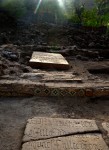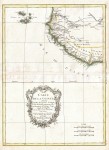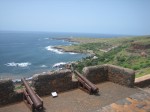 A team of archaeologists from the University of Cambridge has unearthed the remains of the first known Christian church in the tropics on the Cape Verde island of Santiago. The church of Nossa Senhora da Conceição was built around 1470, shortly after the Portuguese discovered the island, out of wood. What the team has found are the remains of an expansion of the church from 1500 with masonry walls and an interior decorated with vibrant colored tile imported from Lisbon.
A team of archaeologists from the University of Cambridge has unearthed the remains of the first known Christian church in the tropics on the Cape Verde island of Santiago. The church of Nossa Senhora da Conceição was built around 1470, shortly after the Portuguese discovered the island, out of wood. What the team has found are the remains of an expansion of the church from 1500 with masonry walls and an interior decorated with vibrant colored tile imported from Lisbon.
Documentary evidence pointed to the location of the first church, so in 2007 the team dug test pits and found foundations and a significant burial ground. With the support of the mayor and the Cape Verde government, archaeologists were able to return this season and fully excavate the site.
“We’ve managed to recover the entire footprint-plan of the church, including its vestry, side-chapel and porch, and it now presents a really striking monument,” said Christopher Evans, Director of the CAU.
“Evidently constructed around 1500, the most complicated portion is the east-end’s chancel where the main altar stood, and which has seen much rebuilding due to seasonal flash-flood damage. Though the chancel’s sequence proved complicated to disentangle, under it all we exposed a gothic-style chapel,” he said.
“This had been built as a free-standing structure prior to the church itself and is now the earliest known building on the islands — the whole exercise has been a tremendous success.”
 The Cape Verde archipelago was discovered in 1456 by Alvise Cadamosto, an Italian explorer hired by Prince Henry the Navigator of Portugal to explore the west coast of Africa. The islands were uninhabited. There weren’t any mammals at all, in fact, or trees. They were, however, conveniently located in the Atlantic 350 miles off the coast of Africa, which would soon make the archipelago an important platform for the transatlantic slave trade. In 1462 the Portuguese founded the first permanent European settlement in the tropics on the Cape Verde island of Santiago. The island and its capital, the city of Ribeira Grande (modern-day Cidade Velha), flourished from the trade in human flesh both economically and culturally, becoming the second richest city in the Portuguese empire and developing through the mixing of European and African cultures into the first Creole society.
The Cape Verde archipelago was discovered in 1456 by Alvise Cadamosto, an Italian explorer hired by Prince Henry the Navigator of Portugal to explore the west coast of Africa. The islands were uninhabited. There weren’t any mammals at all, in fact, or trees. They were, however, conveniently located in the Atlantic 350 miles off the coast of Africa, which would soon make the archipelago an important platform for the transatlantic slave trade. In 1462 the Portuguese founded the first permanent European settlement in the tropics on the Cape Verde island of Santiago. The island and its capital, the city of Ribeira Grande (modern-day Cidade Velha), flourished from the trade in human flesh both economically and culturally, becoming the second richest city in the Portuguese empire and developing through the mixing of European and African cultures into the first Creole society.
 The city declined rapidly in the 18th century after it was sacked by the French pirate Jacques Cassard in 1712. He gutted Cape Verde so thoroughly that, according to his memoirs, he had too much loot to fit on his eight ships and had to leave some of it behind for fear his fleet would sink from the weight. Ribeira Grande never recovered from the Cassard blow. When the slave trade was outlawed in the 19th century, the economic engine of the city died. Necessary maintenance was abandoned and the hill wash carried down into the city by seasonal floods was left to accumulate. The capital was moved to the town of Praia and Ribeira Grande became a sleepy village.
The city declined rapidly in the 18th century after it was sacked by the French pirate Jacques Cassard in 1712. He gutted Cape Verde so thoroughly that, according to his memoirs, he had too much loot to fit on his eight ships and had to leave some of it behind for fear his fleet would sink from the weight. Ribeira Grande never recovered from the Cassard blow. When the slave trade was outlawed in the 19th century, the economic engine of the city died. Necessary maintenance was abandoned and the hill wash carried down into the city by seasonal floods was left to accumulate. The capital was moved to the town of Praia and Ribeira Grande became a sleepy village.
Nossa Senhora da Conceição followed this pattern, falling into disuse around 1790. The archaeological remains from its heyday, however, give us a unique glimpse into the early history of the island. The discovery of the tombstones of dignitaries like mid-16th century town treasurer and slave trader Fernão Fiel de Lugo confirm the existence of people who while known were enveloped in an aura of legend. An estimated 1,000 people were buried under the floor of the church before 1525, an incredible density of information about the dawn of the first Creole society.
Preliminary analysis of samples shows that about half the bodies are African, with the rest from various parts of Europe. An excavation is being planned to collect data for isotope analysis of more bodies to learn more about the country’s founding population and its early slave history.
“From historical texts we have learned about the development of a ‘Creole’ society at an early date with land inherited by people of mixed race who could also hold official positions. The human remains give us the opportunity to test this representation of the first people in Cabo Verde,” said Evans.
Watch this video for an overview of the history of the city and for great footage of the excavation of the church.
[youtube=https://youtu.be/7lDWR5R6EII&w=430]